#staffordshire hoard
Text

I had a enjoyable afternoon in my local museum and art gallery today. I went to see the Spitfire exhibit (which I'll be posting pictures of on Remembrance Sunday) and I took another look at the Staffordshire Hoard exhibition.
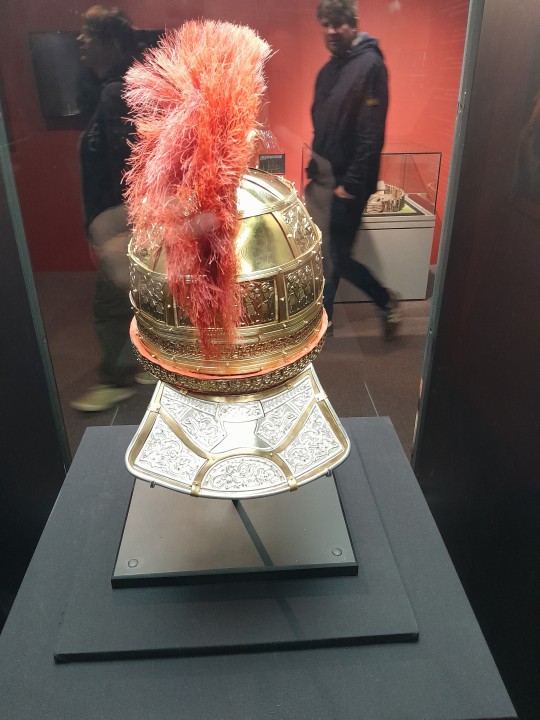
The Anglo-Saxon helmet is a reproduction. The real one (not on display) was assembled from over a thousand gold and silver fragments.

A number of the ancient artifacts discovered at the site were decorations for swords. The blades below are also reproductions.

24 notes
·
View notes
Text
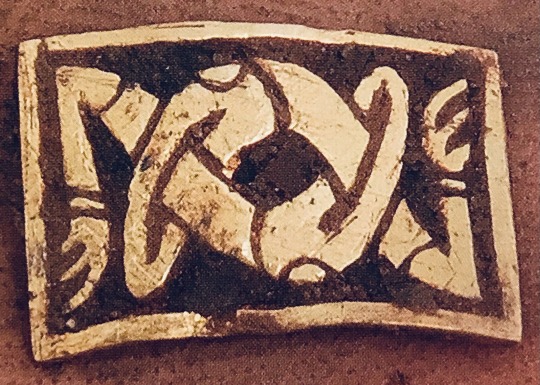
A small gold plate featuring two interlocked animals with single feet, their jaws gripped around each-others throat.
One of over 1600 items discovered in 2009, known as the Staffordshire Hoard. Believed hidden during the seventh or early eighth Century, it is the largest collection of Anglo-Saxon gold ever found.
#gold#vintage jewellery#anglo saxon#treasure#treasure hoard#art#ancient art#ancient britain#staffordshire
22 notes
·
View notes
Text
Everyone should have their stuff back from the British museum,
except the greeks
#because it's very funny to keep the marbles#the egyptians should definitely take their mummies back please#that room has bad vibes#I think the vibes will be much better if they're taken home#there is actually british stuff in the british museum btw#but if you want a really nice british hoard check out birmingham museum and art gallery#it's got the staffordshire hoard
5 notes
·
View notes
Text
Merovingian Era Terminals

A terminal is the decorative end of a brooch. Brooches come in many varieties and sizes, but always in two parts, the head: which is where the needle hinges, and the foot: where the needle is secured behind a hook or curved heel.
The head is often very eyecatching and well decorated. The foot is usually longer than the actual needle and most often tapers to the end, that little tapering end is the terminal.
Roman (military) brooches usually have some kind of stud or geometric element, while Merovingian and Anglo-Saxon brooches have rounded ends which are almost always shaped like a stylized animal head.
There are discussion amidst academics as to what animal is supposedly portrayed, but there is no consensus. Animal head terminals are found all over Europe.
Image: Anglo Saxon terminal (from unidentified larger artifact) from the Staffordshire Hoard. Photographed by “PA” for The Guardian (24/09/2009)
#frankish#merovingian#viking archaeology#archaeology#carolingian#charlemagne#field archaeology#viking mythology#merovingian archaeology#germanic mythology#norse mythology#anglo saxon#viking#field archaeologist#frisian#odin#vikings#germanic#germanic folklore#germanic archaeology#wodan#anglo saxon archaeology#history#jewelry#norse
21 notes
·
View notes
Text
garnet

Unlike most of the other months, January babies only have one birth stone. But oh - what a birthstone it is!
Garnets come in a variety of colors, including the ultra rare blue ones, but the most well known and well loved is the deep rich red. Red garnets are one of the oldest recorded gems for humanity and one that stretched across continents. Garnets can be found in jewelry as far back as the Bronze Age and ancient Romans and Greeks were fond of it as well. The carbuncle gemstone on the High Priest's breastplate in the Old Testament might have been a garnet. They were often found on the jewelry of ancient pharaohs. In fact, archeologists have used garnets to trace historic trade routes, with the 7th century Staffordshire Hoard and the Winfarthing pendant of England both containing garnets from as far away as ancient Sri Lanka. Garnets featured frequently in Migration Period art, a style that arose across Europe and Britain after the collapse of Rome, during the 3rd century, that relied on small, intricate interlocking patterns like the above sword hilt piece.
In modern times, garnets are more than just a pretty face. With a hardness on the Mohs scale from 6 to 7.5, they are often used for their abrasive properties. Garnet grains added to a jet of water can cut through steel!
Just remember, January babies, you're made of tough stuff!
Having such a long history across so much of the world, garnets have netted their fair share of superstitions over the centuries.
In Persia, the garnet was good for protection from natural dangers, like storms and their lightning. In some stories, while there was no light from the moon or the sun during the storm that brought the flood, Noah's ark was lit with the light from a brilliant garnet. Many cultures saw garnets as protection against physical harm and wore them into battle. In fact, during the Crusades, both Christian and Muslim soldiers wore garnets for the exact same reason. Garnets were good at signalling danger since they would grow pale as it approached. They were also supposed to help protect travelers going on long journeys to ensure they came safely home and parting friends would exchange garnets in the belief that the stones would ensure they would meet again. In ancient Egypt, garnets could ward off depression and bad dreams.
The garnet's red color associates it naturally with blood and the stone was supposed to be a cure against inflammation. Too much blood could make you hot-headed, and the garnet was supposed to soothe anger and help with mental clarity and peace of mind. It was also associated with love and friendship. Many older engagement rings were set with garnet as it was supposed to represent loyalty and unchanging affection.
In Medieval Europe, dragon's eyes were sometimes said to be made of garnets. Garnets were also associated with the deep red pomegranate seeds Persephone ate while trapped in the underworld.
Garnets were popular through the Victorian times and are starting to return to popularity as different colored garnets are coming into vogue. Demantoid garnets are a beautiful green color while mandarin garnets are a brilliant golden orange. The iridescent garnet changes color, from red to purple under different lighting. And, as already mentioned, the blue garnet is a deep teal color and was only official in 2017. Garnet lovers have more choices than ever -
but there's something to be said for the classic red garnets that have entranced humanity down through the centuries.

10 notes
·
View notes
Photo

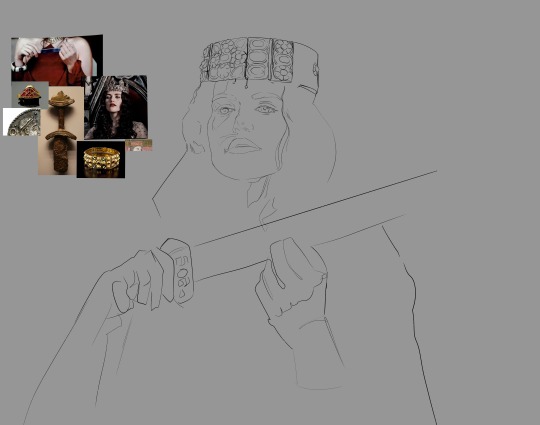




progress and final
-
used the iron crown of lombardy for ref for the corwn, as well as some stuff for the staffordshire hoard as ref for the pommel/hilt, getting closer to period accurate wear
278 notes
·
View notes
Text

my favorite piece from the staffordshire hoard btw. the fucking fis h
2 notes
·
View notes
Photo
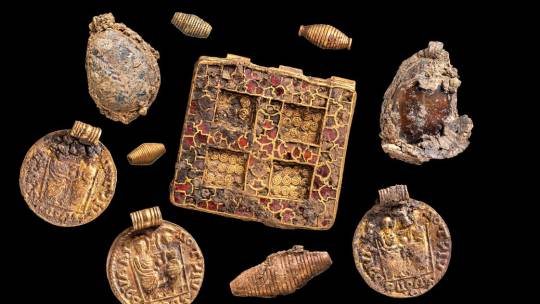


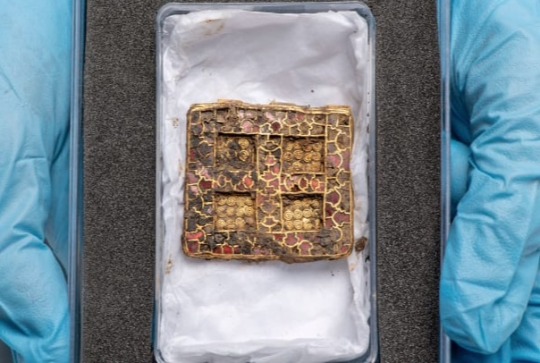
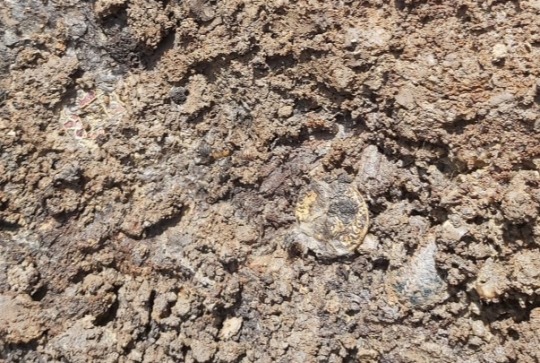
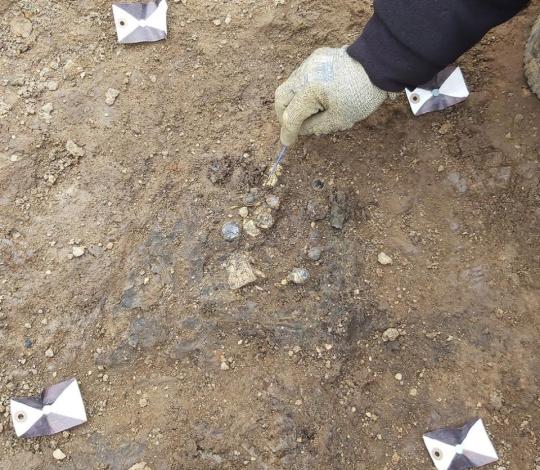
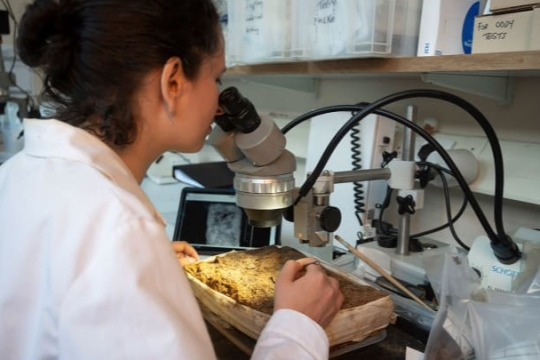
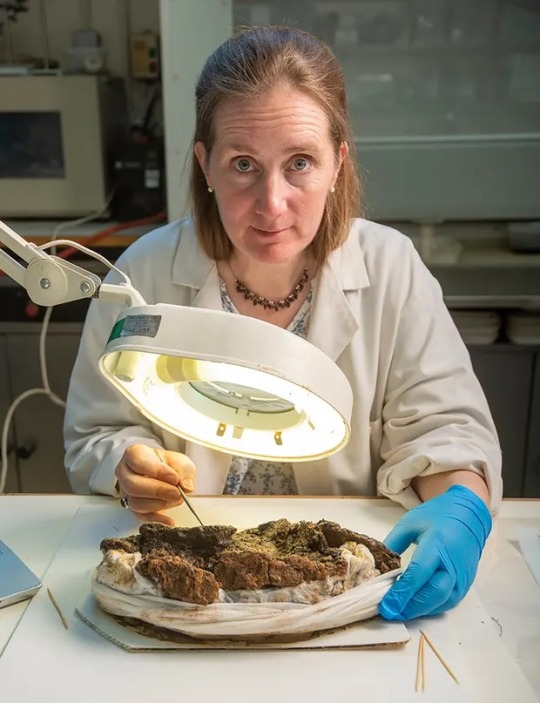

Gold and Jeweled Necklace Found at Burial Site of Powerful Anglo-Saxon Woman in England
Archaeologists have discovered a stunning 1,300-year-old necklace, made of gold, garnets and other semiprecious stones, at an excavation site in central England earmarked for a housing development.
The necklace and other precious objects, called the Harpole Treasure after the local parish in Northamptonshire county where they were unearthed in April, also revealed a powerful role played by some women in Anglo-Saxon England.
The jewelry piece was buried with a woman of high status, who died between 630 AD and 670 AD, according to researchers at the Museum of London Archaeology who unearthed the treasure. The trove also included a relatively large silver cross, two decorated pots and a shallow copper dish.
The Anglo-Saxon bling suggested the woman was powerful in her own right and extremely devout, perhaps an early Christian leader, a princess or an abbess.
The grave site is thought to be the most significant burial from a unique sliver of English history when pagan and Christian beliefs intermingled and women held powerful positions in the early church.
The discovery's importance, the archaeologists said, was of a similar magnitude to that of other monumental Anglo-Saxon treasures unearthed in England, such as Basil Brown's famed find in 1939 at Sutton Hoo, where a warrior king was buried in a ship, and the Staffordshire Hoard of gold and silver artifacts, discovered in 2009 by an amateur metal detectorist in a field in Staffordshire, England.
About a dozen other high-status female burials, known as bed burials, have been discovered elsewhere in England. In some cases, the grave sites included similar necklaces.
Few of these burial sites date back earlier than the 7th century AD, when burials of high-status men were more common, and as Christianity took root, later graves rarely featured valuable objects because being buried with ornate jewelry, such as the necklace, was frowned upon by the early Christian Church, said Lyn Blackmore, a senior finds specialist at MOLA.
"The Harpole Treasure, it's not the richest (bed burial) in terms of the number of artifacts but it is the richest in terms of investment of wealth ... and it has the highest amount of gold and religious symbolism," she said at a news briefing.
X-rays taken of blocks of soil removed from the grave site revealed an ornately decorated but delicate cross cast in silver and mounted on wood. The artifact also had unusual depictions of human faces cast in silver.
Organic matter found in the grave is thought to contain fragments of feathers and textiles like leather, and further study should uncover the nature of the bed burial and whether it had a cover or canopy. The two pots were Frankish in style, Blackmore said, suggesting they came from what is now France or Belgium. The archaeologists hope molecular analysis will allow them to identify the residue in the pots; to date, their analysis has ruled out myrrh.
The skeleton itself was fully decomposed, with the exception of tiny fragments of tooth enamel, but the necklace and other features of the burial convinced the archaeologists that its occupant was female, Blackmore said.
Opulent gold riches
The discovery was made on April 11 but was made public for the first time on Tuesday.
The necklace is the most ostentatious of its type ever to be found in Great Britain, with 30 pendants and beads made of gold, garnets, glass and semiprecious stones strung together along with Roman coins. The striking artifact was found on the penultimate day of an eight-week excavation, said Levente-Bence Balázs, the MOLA site supervisor who first spotted the treasure glinting in the soil.
He was excavating what was thought to be a rubbish pit when he came across the crowns of two teeth, which signaled a burial of some sort. He then saw the rectangular pendant that formed the center of the necklace.
"In 17 years of excavating sites, this was the first time I've found gold. It's not just the artifacts, it's the sheer magnitude of the find," he said.
The excavation work was funded by the house-building company Vistry Group, which said it had waived any rights to the the artifacts that now belong to the state.
he first occupants of the housing development are due to move into their homes in two weeks' time and don't yet know about the treasure that lies beneath their community, said Daniel Oliver, regional technical director at Vistry West Midlands. Nothing has been built on the precise location of the burial, which isn't being made public, he added.
The area where the burial site was found was otherwise unremarkable, with no mounds or other features marking the grave. Archaeologists who worked at the site said they have surveyed the area thoroughly and are confident there is nothing else to find.
Officials at the Museum of London Archaeology said it would take at least two years to study the finds, but hoped the Harpole Treasure would eventually go on public display.
By Katie Hunt.
#Gold and Jeweled Necklace Found at Burial Site of Powerful Anglo-Saxon Woman in England#The Harpole Treasure#Northamptonshire county#ancient tomb#ancient grave#ancient burial#ancient jewelry#ancient artifacts#history#history news#ancient history#ancient culture#ancient civilizations#anglo-saxon#anglo-saxon history#archeology#archeolgst#gold#treasure
41 notes
·
View notes
Photo

“Extremely rare Anglo-Saxon Helmet of gold and silver from the 7th century, reconstructed from fragments found near Lichfield, England. The Staffordshire Hoard is the largest collection of Anglo-Saxon gold and silver ever discovered, held by the Birmingham Museums Trust.”
33 notes
·
View notes
Text
If I could write, I would.
Oh hey, I’ve never written on this blog and it’s almost a decade old. 👋🏻
so it’s 1:45am and I can’t sleep because I’m thinking- you know what, a Sandman/Detectorists crossover fic would be amazing- cute and gentle. If you’ve not seen The Detectorists (Mackenzie Crook and Toby Jones show) off you go and treat yourself- it is all things good.

Anyway, so Hob’s got money stashed all over the place, probably in banks and offshore accounts, sure, but also PROBABLY he’s secreted caches in random places around the country. Got to be prepared for every eventuality after all. AND there’s hoards all over the place in the U.K., seemingly. We’re not talking on a par with the Staffordshire hoard or that one discovered in Norfolk last year, but it’s not a paltry sum that Hob’s got buried, and for some reason, he really needs it, or something from it, now.
So I figure this treasure is somewhere in the Danebury vicinity, except Hob doesn’t remember precisely *where*. It’s been a good few centuries: memories fade and landscapes change. So he joins the DMDC, because how else does one find buried treasure than by metal detecting?
as far as plot goes, that’s it (this is why I’m not a writer 😂). I just want to provide the opportunity for Hob to introduce himself and for Terry to say “Hob… Hob. An appropriately medieval moniker.” In a genially approving manner. And for Hob to go for pints at the Two Brewers with Lance and Andy. And for Dream to overhear Lance’s little speech to Andy re-what a Detectorist is: “See, archaeologists, they gather up the facts, piece the jigsaw together, work out how we lived and find the buildings we lived in, but what we do is... that's different. We unearth the scattered memories, mine for stories, fill in the personality. Detectorists. We're time travellers.” And to raise an eyebrow in mild approval. I don’t know why Dream’s there, that’s for someone else to figure out.
And that magpie that goes around stealing the treasure? That’s 100% Matthew’s role in all this.
I would call it something from the lyrics of Johnny Flynn’s theme song, and pepper it with expansive descriptions of the bucolic beauty of Essex in the late summer.
since I’ve gotten that off my chest, maybe I can sleep now?
#the sandman#hob gadling#dream of the endless#the sandman fanfic#the detectorists#matthew the raven#late night musings#i don’t know how to tag#I just think this would be cute right#first post on tumblr#hello tumblr
5 notes
·
View notes
Text
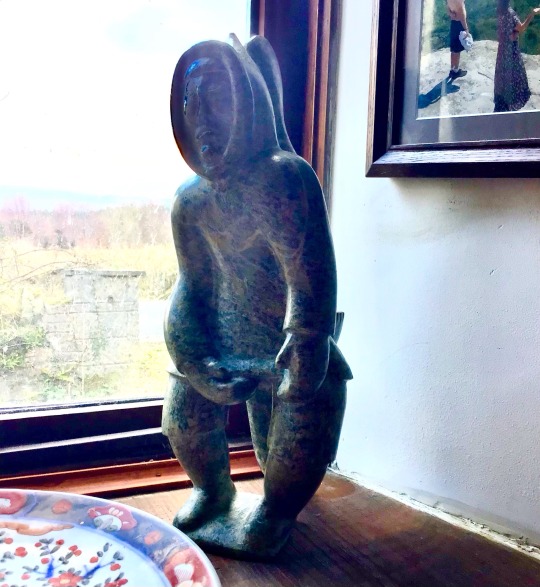


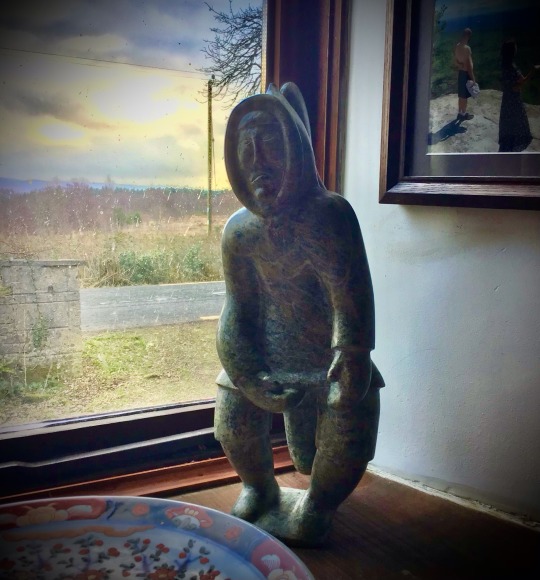
From above the Arctic circle - to my windowsill.
Inuit art is mysterious, strong…the shapes are solid and carefully considered. Carved from a single chunk of incredibly heavy green stone, this hunter with his seal strapped to his back - delights me. The way he is standing. How his mittens curl inward, and the growl on his face…
Anyway…
He had to come with me.
Last Saturday was Dave Stuart’s first foray into the world of online auctioneering. I honestly didn’t think he could pull it off, but it’s OK to be proved wrong.
The room was PACKED with stuff for sale, most of which belongs to himself.
We have been deeply concerned for David, as he is behaving oddly. He learned how to bid on the online auctions, and has succumbed to a hoarding addiction which has been consuming his every waking hour. He sits hunched over his laptop in the shabby little office, bidding against the rest of the world for high-end antiques. He is spending a LOT of money, then jumps into a van and drives all over the country to pick up his prizes.
David is not a young man - closing in on 80? His auction sales have remained our happy-hunting-ground for years now - we bid on decent (but damaged) antiques, and can bring them home for very little money. I get to work - restore / repair / spruce-up - and move it on to a better auction for resale.
This is our “extra” income - and we’ve loved every minute of it.
The Stuart auctions have become a bizarre circus over the last few months. He has had little or no stock to sell - the folks who consign their things have looked elsewhere, because instead of holding an auction every Saturday - he runs only two sales a month. In the world of the numblies and the dealers in crap to buy and sell - this is a deal-breaker. It’s easier to move items into one of the other houses that sell EVERY WEEK - and put a little cash into their pockets sooner rather than later.
David has CRAMMED his place with extreme high-end antiques. His first obsession was Staffordshire figures. First one, then ten, suddenly a hundred are all stood cheek-to-cheek along the tables which are normally reserved for things being sold.
He’s not selling these.
Likewise antique oil lamps with beautiful glass shades. First five, then 25, now over a hundred - none of which are being sold. They belong to him.
The auction room is filling up with lovely things, but what is actually being sold is crap. Yards of blue rope. Chunks of old chain. Plastic kettles with no lids, a box of broken china, and maybe an extinct radio with no knobs….
German mid-century art pottery.
Then came the clocks. A line of magnificent mantle clocks, marked the beginning of the new obsession - then came the 18th century brass dial tall-case grandfather clocks. Beautiful, expensive time pieces which now march the length and breadth of the auction room. There are over 20 of these - all acquired within the last two months.
None of these things are being sold, just hoarded. The back rooms are crammed with stacks of fine oriental carpets, statuary, brass standard lamps, and whatever else his itchy trigger-finger bid on during somebody else’s auction online….
We stopped in to look at his upcoming sale, and he had packed what was left of the room with BIG brown furniture. Highly polished and restored Georgian tables, chests of drawers, sideboards, etc - all of which he has paid far too much for, and cannot sell to his usual customers. (Including us.)
“I’m going online” sez he. “I need to get better bidders to sell better things, and have joined easyliveauctions “
Color me dubious. David can’t run his own microphone, the woman in the office can’t run the credit card machine, and he struggles with his own cellphone.
But he managed to pull it all off - and I am impressed! The sale was packed with new people. The computer link for live bidding was handled by a woman who sat beside him on the podium, and his wife took care of phone bids.
Daaaaammmnnnn……!
Nobody was happy. Everybody was cramped, miserable, uncomfortable, nowhere to sit, and the usual camaraderie is dead and buried.
Bidding on the floor was fine - but then the internet bids trashed the assembled mob - and took things into the stratosphere. Grumbling was audible, tempers raw. A strange, grim man who was shaped like an actual ham - stood with a penciled list at the back of the room - and paid whatever he had been told on the fine furniture. €2000 for a Georgian table. £400 for a Victorian work table. Prices un-dreamed of before. He took no pleasure in his work, didn’t meet anyone’s eyes, but went about his task with silent, unsmiling determination. He carried everything out to his huge white van, loaded up with ties and blankets - and away he went.
David’s auction was a success. For David. I fear it will only feed the fire of his shopping addiction, and lead to more frantic acquisition.
In the meantime - I managed to bring home the hunter and his seal - because I love him. One of the last pieces to fall under the hammer of a three and a half hour sale (?!) - and nobody in ireland likes Inuit sculpture. He can live here with me, and I will admire his sturdy form in the morning light -for years to come.
The times they are a’changing.
2 notes
·
View notes
Photo

A few of the pieces from the Staffordshire Hoard that are on display at Sutton Hoo. I am continuously amazed at the masterful craftsmanship of the Anglo-Saxons. #SuttonHoo #staffordshirehoard #historynerd (at Sutton Hoo) https://www.instagram.com/p/Ci5chLIMyJ9/?igshid=NGJjMDIxMWI=
4 notes
·
View notes
Text
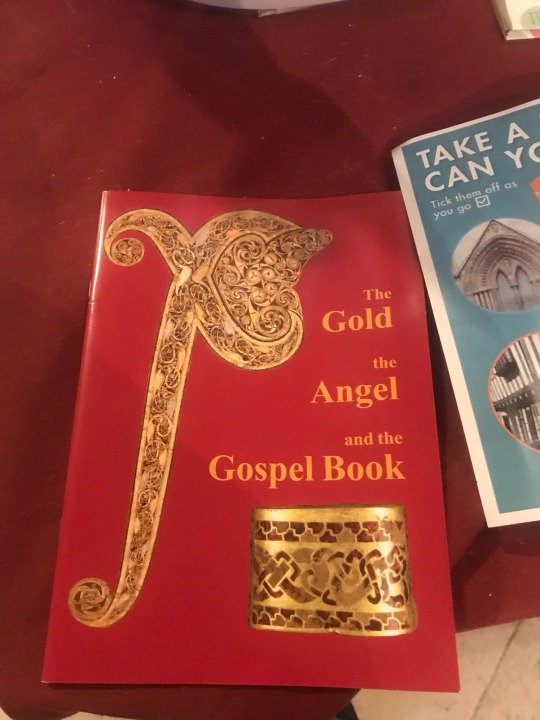
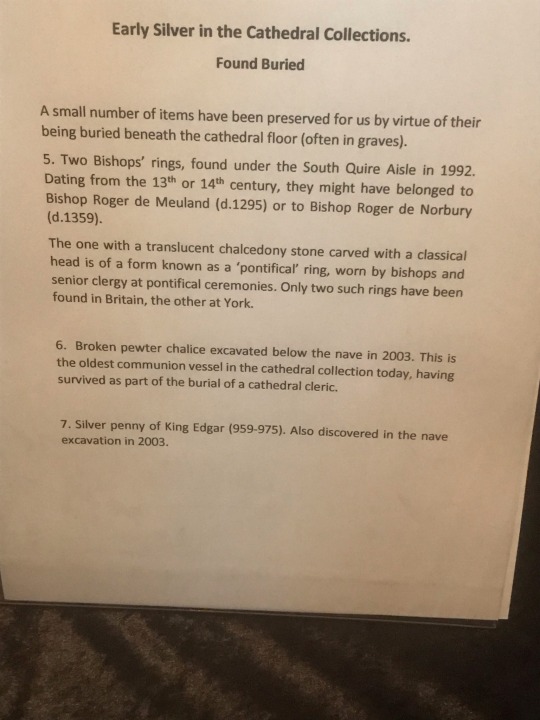


A book about the Staffordshire Hoard and archaeological discoveries in the cathedral.
3 notes
·
View notes
Text
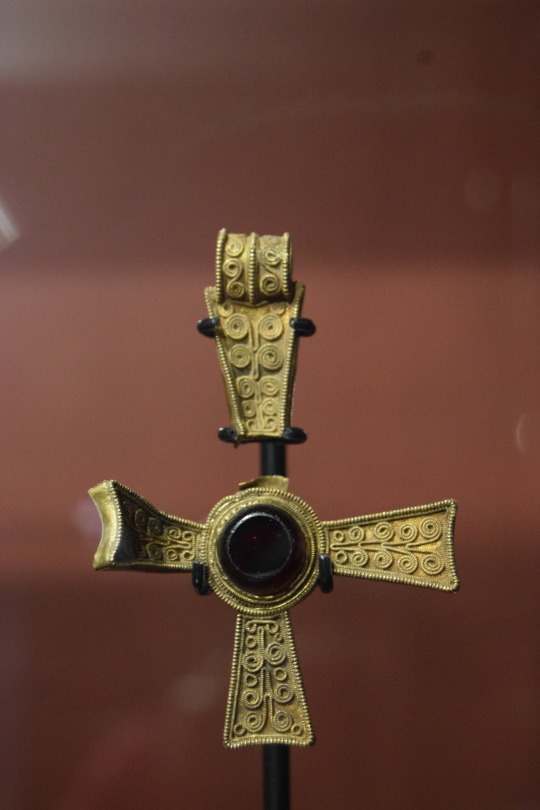
Anglo-Saxon cross, Staffordshire Hoard, Potteries Museum and Art Gallery
1 note
·
View note
Text
Immaculate hoard of gold coins worth £30,000 dating back to Henry VIII unearthed in the grounds of country house in Staffordshire
0 notes